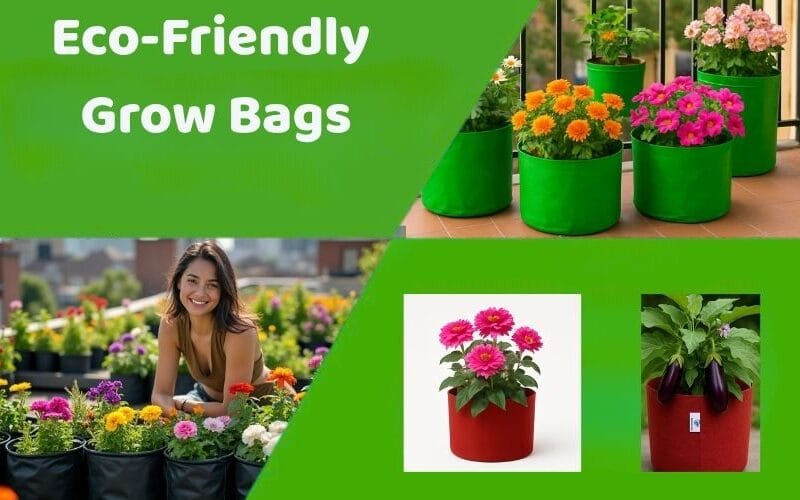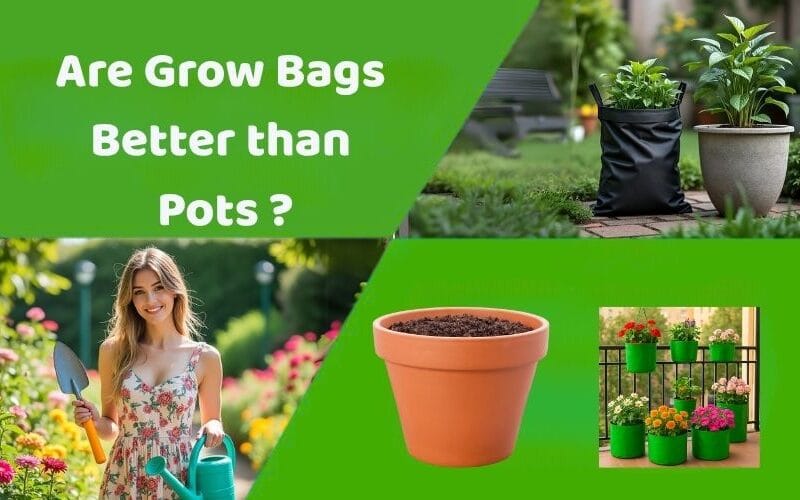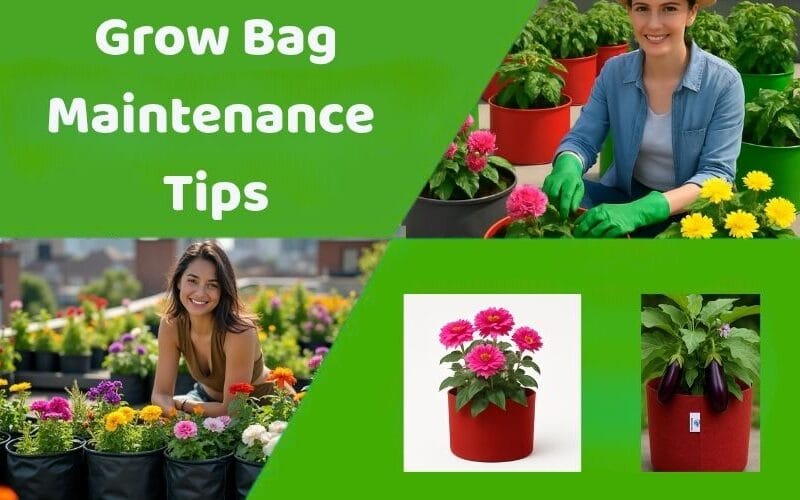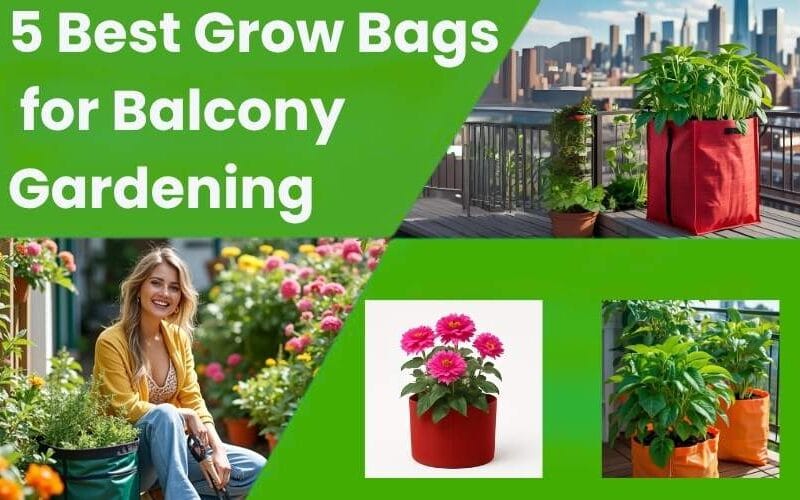Grow Herbs in Grow Bags Easily: तुलसी और पुदीना उगाएं आसानी से! आपका Easy Guide
ताज़ी हर्ब्स का इस्तेमाल खाने का स्वाद बढ़ा देता है, और इनकी खुशबू मन को सुकून देती है। तुलसी (Tulsi) और पुदीना (Mint) तो लगभग हर भारतीय घर में इस्तेमाल होते हैं, चाहे पूजा के लिए हो या खाने में।
अच्छी बात यह है कि इन हर्ब्स को उगाना बहुत आसान है, खासकर जब आप Grow Bags का इस्तेमाल करते हैं! Grow Bags कम जगह लेते हैं, Lightweight होते हैं, और हर्ब्स की Healthy Growth के लिए Perfect हैं।
अगर आप अपने Home Garden में Grow Herbs in Grow Bags का सोच रहे हैं और जानना चाहते हैं कि तुलसी और पुदीना जैसे Popular हर्ब्स को आसानी से कैसे उगाएं, तो यह Blog Post आपके लिए ही है! यह एक Easy Guide है जो आपको बताएगा कि कैसे आप अपने Grow Bags में ढेर सारी ताज़ी हर्ब्स पा सकते हैं।
चलिए, सीखते हैं कि Grow Herbs in Grow Bags Easily कैसे करें, खासकर तुलसी और पुदीने के लिए:
Grow Herbs in Grow Bags: तुलसी (Tulsi) और पुदीना (Mint) उगाने का Easy Guide
तुलसी और पुदीना को Grow Bags में उगाना बहुत Simple है। इन Steps को फॉलो करें:
1. सही Grow Bag चुनें (Choose the Right Grow Bag)
तुलसी और पुदीना की जड़ें बहुत गहरी नहीं जातीं, इसलिए आपको बहुत बड़े Bags की ज़रूरत नहीं है।
तुलसी के लिए: 8-10 इंच गहरा और इतना ही चौड़ा Grow Bag एक पौधे के लिए काफी है।
पुदीना के लिए: पुदीना तेज़ी से फैलता है, इसलिए इसे फैलने के लिए थोड़ी चौड़ाई चाहिए। 8-10 इंच गहरा और 10-12 इंच चौड़ा Grow Bag अच्छा रहेगा। आप चाहें तो पुदीना को अलग Bag में ही उगाएं ताकि यह दूसरे पौधों में न फैले।
सही Grow Bag चुनना Grow Herbs in Grow Bags का पहला Step है।
2. Potting Mix तैयार करें (Prepare Potting Mix)
हर्ब्स को भी अच्छी Drainage वाली मिट्टी पसंद है। Grow Bags के लिए हल्की और भुरभुरी Potting Mix बनाएं:
50% गार्डन मिट्टी + 30% कंपोस्ट + 20% कोकोपीट या रेत।
यह Mix जड़ों को हवा देगा और पानी को रोकेगा नहीं, जो Grow Herbs in Grow Bags के लिए ज़रूरी है।
3. Grow Bag भरें और लगाएं (Fill and Plant)
Grow Bag को Potting Mix से भरें, ऊपर से 1-2 इंच खाली रखें।
तुलसी: बीज से या Cutting (टहनी) से उगा सकते हैं। अगर बीज हैं, तो उन्हें मिट्टी की ऊपरी परत पर हल्का फैलाकर पतली मिट्टी से ढक दें। अगर Cutting है, तो उसे सीधे Potting Mix में लगा दें।
पुदीना: पुदीना Cutting से उगाना सबसे आसान है। बाज़ार से लाए गए पुदीने की डंठलों को पानी में रखें जब तक जड़ें न निकलें, या सीधे Potting Mix में लगा दें। पुदीना तेज़ी से बढ़ता है!
यह Step आपके Grow Herbs in Grow Bags Project को शुरू करता है।
4. पानी दें और जगह चुनें (Water and Place)
लगाने के तुरंत बाद Bag को अच्छी तरह पानी दें।
तुलसी: इसे अच्छी धूप पसंद है (कम से कम 4-6 घंटे)।
पुदीना: इसे थोड़ी कम धूप या Semi-Shade पसंद है। ज़्यादा तेज़ धूप से इसकी पत्तियां जल सकती हैं।
अपने Grow Bags को सही जगह रखें जहाँ उन्हें ज़रूरत के हिसाब से धूप मिले।
5. देखभाल और कटाई (Care and Harvesting)
Grow Herbs in Grow Bags के लिए Regular Care ज़रूरी है:
पानी: मिट्टी की नमी चेक करें। पुदीना को तुलसी से ज़्यादा पानी चाहिए हो सकता है, खासकर गर्मियों में। Overwatering से बचें।
खाद: बहुत ज़्यादा खाद की ज़रूरत नहीं। हर 3-4 हफ्ते में थोड़ा Organic Liquid Fertilizer दे सकते हैं।
कटाई: ज़रूरत के हिसाब से पत्तियां तोड़ते रहें। पुदीने को ऊपर से Cut करते रहें ताकि वह घना हो और फैले। तुलसी में बीज बनने से पहले ऊपरी फूलों को हटा दें ताकि पौधा झाड़ीदार बना रहे।
👇 Explore more gardening tips in this post
निष्कर्ष:
तुलसी और पुदीना जैसे Useful हर्ब्स को Grow Herbs in Grow Bags Easily उगाना बहुत Simple है। सही Bag, सही Potting Mix और थोड़ी सी Regular Care के साथ, आप अपनी बालकनी या किचन विंडो में ताज़ी और सुगंधित हर्ब्स का अपना छोटा सा Garden बना सकते हैं।
तो अगर आप Gardeining में Newbie हैं और कुछ आसान उगाना चाहते हैं, तो Grow Herbs in Grow Bags से शुरुआत करें!
Grow Bag Size Chart
| Size (L x W x H) | Suitable Plants | Buy Now | |
|---|---|---|---|
| 6x6 inch Geo Fabric | तुलसी, धनिया, पुदीना, अजवाइन, हरा प्याज, गेंदा | Buy Now | |
| 9x9 inch Geo Fabric | तुलसी, मिर्च, धनिया, गुलाब, पोदीना, टमाटर | Buy Now | |
| 8x8 inch Geo Fabric | तुलसी, मिर्च, पुदीना, धनिया, | Buy Now | |
| 24x24 inch Geo Fabric | अंजीर, अमरूद, स्ट्रॉबेरी, ड्रैगन फ्रूट, कीवी, पैशन फ्रूट | Buy Now | |
| 18x9 inch Geo Fabric | पालक, मेथी, धनिया, पुदीना, अजवाइन, हरा प्याज | Buy Now | |
| 18x18 inch Geo Fabric | Strawberry, Lemon, Dwarf Mango, Tomato, Cucumber | Buy Now | |
| 9x9 inch HDPE Green | तुलसी, मिर्च, धनिया, गुलाब, पोदीना, टमाटर | Buy Now | |
| 36x12x12 inch HDPE Green | टमाटर, भिंडी, बैंगन, लौकी, कद्दू, फूलगोभी | Buy Now | |
| 24x9 inch HDPE Green | पालक, मेथी, धनिया, पुदीना, , सिलंट्रो | Buy Now | |
| 24x9 inch Grey | पालक, मेथी, धनिया, पुदीना, हरा प्याज, सिलंट्रो | Buy Now | |
| 24x6 inch HDPE Green | पालक, मेथी, धनिया, पुदीना, हरा प्याज, सिलंट्रो | Buy Now | |
| 24x12x12 inch HDPE Green | टमाटर, मिर्च, बैंगन, भिंडी, हरा धनिया, पालक | Buy Now | |
| 24x12 inch HDPE Green | स्ट्रॉबेरी, अंजीर, नींबू, ब्लूबेरी, लेमन ग्रास, टमाटर | Buy Now | |
| 18x18 inch HDPE Green | Strawberry, Lemon, Dwarf Mango, Tomato, Cucumber | Buy Now | |
| 18x12x9 inch HDPE Green | टमाटर, मिर्च, बैंगन, भिंडी, हरा धनिया, पालक | Buy Now | |
| 18x12x12 inch HDPE Green | टमाटर, मिर्च, बैंगन, भिंडी, हरा धनिया, पालक | Buy Now | |
| 16x10x8 inch HDPE Green | टमाटर, मिर्च, बैंगन, भिंडी, हरा धनिया, पालक | Buy Now | |
| 15x6 inch HDPE Green | Strawberry, Green Chili, Mint, Tulsi, Baby Spinach | Buy Now | |
| 15x6 inch Black | Strawberry, Green Chili, Mint, Tulsi, Baby Spinach | Buy Now | |
| 15x18 inch HDPE Green | Strawberry, Lemon, Mint, Green Chili, Spinach, Coriander | Buy Now | |
| 15x15 inch Red | Strawberry, Lemon, Mint, Green Chili, Spinach, Coriander | Buy Now | |
| 15x15 inch HDPE Green | Strawberry, Lemon, Mint, Green Chili, Spinach, Coriander | Buy Now | |
| 15x15 inch Black | Strawberry, Lemon, Mint, Green Chili, Spinach, Coriander | Buy Now | |
| 12x6 inch HDPE Green | Mint, Tulsi, Coriander, Green Chili, Baby Spinach | Buy Now | |
| 12x18 inch HDPE Green | Buy Now | ||
| 12x16 inch HDPE Green | Strawberry, Lemon, Green Chili, Mint, Spinach, Coriander | Buy Now | |
| 12x12 inch Red | Strawberry, Green Chili, Mint, Coriander, Baby Spinach | Buy Now | |
| 12x12 inch HDPE Green | Strawberry, Green Chili, Mint, Coriander, Baby Spinach | Buy Now | |
| 12x12 inch Grey | Strawberry, Green Chili, Mint, Coriander, Baby Spinach | Buy Now | |
| 12x12 inch Black | Strawberry, Green Chili, Mint, Coriander, Baby Spinach | Buy Now | |
| 12x10 inch HDPE Green | Strawberry, Green Chili, Mint, Coriander, Baby Spinach | Buy Now | |
| 10x6 inch HDPE Green | Mint, Tulsi, Coriander, Green Chili | Buy Now | |
| 10x10 inch Red | Mint, Tulsi, Coriander, Green Chili | Buy Now | |
| 10x10 inch HDPE Green | Mint, Tulsi, Coriander, Green Chili | Buy Now | |
| 10x10 inch Grey | Mint, Tulsi, Coriander, Green Chili | Buy Now | |
| 10x10 inch Black | Mint, Tulsi, Coriander, Green Chili | Buy Now |
Grow Herbs in Grow Bags – अक्सर पूछे जाने वाले सवाल (FAQs)
Q1: Grow Bags में कौन सी हर्ब्स उगाना सबसे आसान है?
A: तुलसी, पुदीना, धनिया, करी पत्ता, एलोवेरा जैसी हर्ब्स Grow Bags में उगाना बहुत आसान है। ये सभी Grow Herbs in Grow Bags के लिए बढ़िया हैं।
Q2: तुलसी के लिए किस साइज़ का Grow Bag चाहिए?
A: तुलसी के एक पौधे के लिए 8-10 इंच गहरा Grow Bag काफी है।
Q3: पुदीना को Grow Bags में उगाते समय क्या ध्यान रखें?
A: पुदीना तेज़ी से फैलता है, इसलिए उसे फैलने के लिए थोड़ी ज़्यादा चौड़ाई दें या अलग Bag में लगाएं। उसे ज़्यादा धूप की बजाय Semi-Shade पसंद है। यह Grow Herbs in Grow Bags में पुदीना उगाने की Key Tip है।
Q4: Grow Bags में हर्ब्स को कितनी बार पानी देना चाहिए?
A: मिट्टी की ऊपरी परत सूखने पर पानी दें। पुदीना को तुलसी से थोड़ी ज़्यादा नमी चाहिए हो सकती है।
Q5: क्या Grow Bags में हर्ब्स को खाद देना ज़रूरी है?
A: बहुत ज़्यादा खाद की ज़रूरत नहीं होती। हर 3-4 हफ्ते में थोड़ा Organic Liquid Fertilizer दे सकते हैं।
Q6: क्या मैं एक ही Grow Bag में तुलसी और पुदीना एक साथ उगा सकता हूँ?
A: Generally Recommended नहीं है क्योंकि पुदीना बहुत तेज़ी से फैलता है और तुलसी की ग्रोथ को दबा सकता है। Grow Herbs in Grow Bags के लिए इन्हें अलग-अलग Bags में लगाना बेहतर है।












